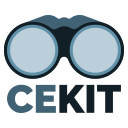Base images¶
Contents
This chapter discusses support for creating images that extend the scratch image
to build base images.
Introduction¶
Tip
Please read the Docker documentation on scratch base image.
The scratch image is a special type of image. It is an empty image and the FROM scratch
instruction in Dockerfile results in no-op when building the container image. There are a few
use-cases for such an image:
- Storing native binaries
It is very popular in the cloud-native era to use languages that produce native binaries which are packaged in a container image format and distributed this way. One of the most popular languages is Golang.
Tip
You may be interested in multi-stage builds as well.
- Storing shared content (for example metadata)
- Sometimes there is a requirement to store metadata (for example YAML files) in a container image so that it can be versioned and used elsewhere.
CEKit implementation¶
Support for scratch base image is a special case in CEKit. This means that some of the features
you are used to may not work properly.
You need to ensure that modules you are including are written in a way so these can be installed and executed in an environment without operating system libraries.
In case of such container images it is important to understand how artifacts are
put inside of them. By default CEKit copies artifacts into a temporary directory which
are later handled by modules (copied to correct places, permissions are managed, etc).
For scratch container images it won’t work, because we don’t have the operating
system that would make it possible.
In this case, the dest keyword should be used to define the destination directory
of the particular artifact.
name: "cekit-scratch"
version: "1.0.0"
from: "scratch"
description: "Minimal scratch example"
labels:
- name: "io.cekit.test"
value: "This is a CEKit test label"
envs:
- name: "CEKIT_TEST"
value: "test"
artifacts:
# Both files will be added to a /files directory in the container image
# The /files directory itself will be created
- name: "file1"
path: metadata/test-file.txt
dest: /files/
- name: "file2"
path: metadata/other.txt
dest: /files/
# Whole 'metadata' directory (path relative to image descriptor) will be copied to
# the container and placed in /target directory
- name: "dir"
path: metadata
dest: /target
In case of scratch container images it is safe to assume that following features are supported:
- Artifacts with
destproperty defined - Environment variables
- Labels
- Entrypoint and command
Below you can find a multi-stage build which builds a Go binary in first stage and then it is copied to the resulting image which is an empty container image. Additionally the binary is set as an entrypoint.
- name: builder
version: 1.0.0
from: golang:1.7.3
modules:
repositories:
- path: modules
install:
# Module required to build the application
- name: build
- name: some/app
version: 12
from: scratch
description: Our application
artifacts:
- name: application
# Name of the image from where the binary will be copied
image: builder
# Path where the binary can be found in the 'builder' image
path: /tmp/scripts/build/hello-world
# Target file name of the artifact
target: entrypoint
# Destination directory in the image
dest: /bin
run:
entrypoint: ["/bin/entrypoint"]
Note
You can find above example in the CEKit source repository. It’s run as part of integration tests.
